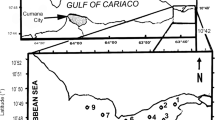Abstract
Examination of washings of the ceriantharian Pachycerianthus maua (Carlgren) and its phoronid symbiont Phoronis australis Haswell in New Caledonian waters revealed two species of symbiotic copepods belonging to the family Sabelliphilidae (Cyclopoida). Phoronicola spinulatus Boxshall & Humes, 1988, the only other copepod known to be associated with a phoronid and originally described from Hong Kong, was found on both the lophophore of Phoronis australis and the tentacular crown of Pachycerianthus maua. Both sexes of Phoronicola spinulatus are redescribed based on the New Caledonian material and re-examination of the type-material revealed some observational errors in the original description. Myxomolgus hoi n. sp. was exclusively found on the ceriantharian host and appears most closely related to its only known Pacific congener, M. invulgus Kim, 2001, in lacking the strong spines on antennulary segments 1–2, the presence of closely set, fine teeth along the convex margin of the mandibular blade, and the absence of a proximal bulbous protrusion along the inner margin of leg 5 exopod. Differences between both species are found in the rostrum, antennule, antenna, maxillule, leg 4, caudal rami and body size. The relatively low number of specimens of P. spinulatus recovered from washings of the lophophores (and its presence on Pachycerianthus maua) suggests that its real host is a ceriantharian rather than a phoronid. It is conceivable that both Phoronicola spinulatus and M. hoi n. sp. live and feed on/inside the mucilaginous ceriantharian tube rather than on the lophophore or tentacular crown of their respective hosts.





Similar content being viewed by others
References
Bocquet, C., & Stock, J. H. (1958). Copépodes parasites d’invertébrés des côtes de France. VI. Description de Paranthessius myxicolae nov. sp., copépode semi-parasite du Sabellidae Myxicola infundibulum (Rénier). Proceedings van de Koninklijke Nederlandse Akademie van Wetenschappen (C), 61, 243–253.
Bocquet, C., & Stock, J. H. (1964a). Copépodes parasites d’invertébrés des côtes de France. XVIIa. Le genre Sabelliphilus M. Sars, 1862 (Copépodes Cyclopoïdes, famille des Lichomolgidae). Proceedings van de Koninklijke Nederlandse Akademie van Wetenschappen (C), 67, 157–174.
Bocquet, C., & Stock, J. H. (1964b). Copépodes parasites d’invertébrés des côtes de France. XVIIb. Le genre Sabelliphilus M. Sars, 1862. (Copépodes Cyclopoïdes, famille des Lichomolgidae). Proceedings van de Koninklijke Nederlandse Akademie van Wetenschappen (C), 67, 175–181.
Bocquet, C., Stock, J. H., & Kleeton, G. (1963). Copépodes parasites d’invertébrés des côtes de la Manche. X. Cyclopoïdes poecilostomes associés aux Annélides Polychètes, dans la région de Roscoff. Archives de Zoologie expérimentale et générale, 102 (Notes et Revue, 1), 20–40.
Boxshall, G. A., & Halsey, S. H. (2004). An introduction to copepod diversity. London: The Ray Society, xv + 966 pp.
Boxshall, G. A., & Humes, A. G. (1988). A new genus of Lichomolgidae (Copepoda: Poecilostomatoida) associated with a phoronid in Hong Kong. Bulletin of the British Museum of Natural History (Zoology), 54, 301–307.
Carlgren, O. (1900). Ostafrikanische Actinien. Mitteilungen aus dem Naturhistorischen Museum in Hamburg, 17, 21–144.
Emig, C. C., Herberts, C., & Thomassin, B. A. (1972). Sur l’association de Phoronis australis (Phoronida) avec Cerianthus maua (Ceriantharia) dans les zones récifales de Madagascar. Marine Biology, 15, 304–315.
Gotto, R. V. (1970). Observations on the orientation and feeding of the copepod Sabellophilus elongatus M. Sars on its fan-worm host. Proceedings of the Zoological Society of London, 133, 619–628.
Holmes, J. M. C., & Gotto, R. V. (1992). A list of the Poecilostomatoida (Crustacea: Copepoda) of Ireland. Bulletin of the Irish Biogeographical Society, 15, 1–33.
Humes, A. G., & Boxshall, G. A. (1996). A revision of the lichomolgoid complex (Copepoda: Poecilostomatoida), with the recognition of six families. Journal of Natural History, 30, 175–227.
Humes, A. G., & Gooding, R. U. (1964). A method for studying the external anatomy of copepods. Crustaceana, 6, 238–240.
Humes, A. G., & Stock, J. H. (1972). Preliminary notes on a revision of the Lichomolgidae, cyclopoid copepods mainly associated with marine invertebrates. Bulletin Zoölogisch Museum, Universiteit van Amsterdam, 2, 121–133.
Humes, A. G., & Stock, J. H. (1973). A revision of the family Lichomolgidae Kossmann, 1877, cyclopoid copepods mainly associated with marine invertebrates. Smithsonian Contributions to Zoology, 127, 1–368.
Huys, R., & Boxshall, G. A. (1991). Copepod evolution. London: The Ray Society, 468 pp.
ICZN (International Commission on Zoological Nomenclature) (1999). International Code of Zoological Nomenclature. (Fourth Edition). London: The International Trust for Zoological Nomenclature, xxx + 306 pp.
Kim, I.-H. (2001). A new genus and two new species of Copepoda (Poecilostomatoida, Sabelliphilidae) associated with the tubicolous polychaetes in the Yellow Sea. Korean Journal of Biological Sciences, 5, 1–9.
Kim, I.-H. (2006). Eupolymniphilus orientalis n. sp. (Copepoda, Cyclopoida, Sabelliphilidae) from intertidal burrows in Korea, with the recognition of four species in the genus. Crustaceana, 79, 573–582.
Kim, I.-H. (2009). Poecilostome copepods (Crustacea: Cyclopoida) associated with marine invertebrates from tropical waters. Korean Journal of Systematic Zoology, Special Issue, 7, 1–90.
Kossmann, R. (1877). Zoologische Ergebnisse einer im Auftrage der Königlichen Academie der Wissenschaften zu Berlin ausgefürten Reise in die Küstengebiete des Rothen Meeres. Hälfte 1(4), Entomostraca, 1. Theil, Lichomolgidae. Leipzig: 1–24, plates 1–6.
Laboute, P., & Richer de Forges, B. (2004). Lagons et récifs de Nouvelle-Calédonie. Nouméa: Editions Catherine Ledru, 520 pp.
Molodtsova, T. (2007). Tube anemones (Ceriantharia Anthozoa) of New Caledonia. In: Payri, C. E., & Richer de Forges, B. (Eds) Compendium of marine species of New Caledonia. Documents scientifiques et techniques, IRD Nouméa, II7 (volume spécial, deuxième édition), p. 133.
Acknowledgement
Special thanks are due to Bertrand Richer de Forges and Pierre Laboute (IRD, Nouméa) for hosting and assisting RH during his collecting survey in New Caledonia (October 2004).
Author information
Authors and Affiliations
Corresponding author
Rights and permissions
About this article
Cite this article
Kim, IH., Huys, R. Sabelliphilidae (Copepoda: Cyclopoida) associated with the tube anemone Pachycerianthus maua (Carlgren) and the horseshoe worm Phoronis australis Haswell off New Caledonia. Syst Parasitol 83, 51–64 (2012). https://doi.org/10.1007/s11230-012-9369-4
Received:
Accepted:
Published:
Issue Date:
DOI: https://doi.org/10.1007/s11230-012-9369-4




